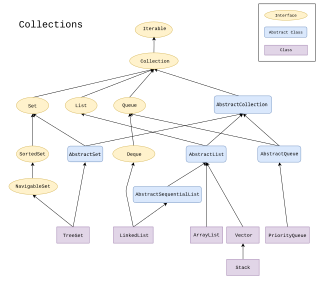
Java is a high-level, class-based, object-oriented programming language that is designed to have as few implementation dependencies as possible. It is a general-purpose programming language intended to let programmers write once, run anywhere (WORA), meaning that compiled Java code can run on all platforms that support Java without the need to recompile. Java applications are typically compiled to bytecode that can run on any Java virtual machine (JVM) regardless of the underlying computer architecture. The syntax of Java is similar to C and C++, but has fewer low-level facilities than either of them. The Java runtime provides dynamic capabilities that are typically not available in traditional compiled languages.
In multi-threaded computer programming, a function is thread-safe when it can be invoked or accessed concurrently by multiple threads without causing unexpected behavior, race conditions, or data corruption. As in the multi-threaded context where a program executes several threads simultaneously in a shared address space and each of those threads has access to every other thread's memory, thread-safe functions need to ensure that all those threads behave properly and fulfill their design specifications without unintended interaction.
In software engineering, double-checked locking is a software design pattern used to reduce the overhead of acquiring a lock by testing the locking criterion before acquiring the lock. Locking occurs only if the locking criterion check indicates that locking is required.
In computer science, a lock or mutex is a synchronization primitive that prevents state from being modified or accessed by multiple threads of execution at once. Locks enforce mutual exclusion concurrency control policies, and with a variety of possible methods there exist multiple unique implementations for different applications.

A race condition or race hazard occurs in electronics, software, or other system when the system's behavior depends on the timing or order of uncontrollable events, leading to unpredictable outcomes. In software, race conditions occur when multiple threads or processes attempt to access or change a variable, file, or other resource at the same time without proper synchronization. In logic circuits, race conditions arise when signals traveling along different paths reach a component at different times, resulting in unexpected outputs.
In computer science and engineering, transactional memory attempts to simplify concurrent programming by allowing a group of load and store instructions to execute in an atomic way. It is a concurrency control mechanism analogous to database transactions for controlling access to shared memory in concurrent computing. Transactional memory systems provide high-level abstraction as an alternative to low-level thread synchronization. This abstraction allows for coordination between concurrent reads and writes of shared data in parallel systems.

The Java collections framework is a set of classes and interfaces that implement commonly reusable collection data structures.
In computer science, synchronization is the task of coordinating multiple processes to join up or handshake at a certain point, in order to reach an agreement or commit to a certain sequence of action.
The Java programming language and the Java virtual machine (JVM) is designed to support concurrent programming. All execution takes place in the context of threads. Objects and resources can be accessed by many separate threads. Each thread has its own path of execution, but can potentially access any object in the program. The programmer must ensure read and write access to objects is properly coordinated between threads. Thread synchronization ensures that objects are modified by only one thread at a time and prevents threads from accessing partially updated objects during modification by another thread. The Java language has built-in constructs to support this coordination.

Parasoft is an independent software vendor specializing in automated software testing and application security with headquarters in Monrovia, California. It was founded in 1987 by four graduates of the California Institute of Technology who planned to commercialize the parallel computing software tools they had been working on for the Caltech Cosmic Cube, which was the first working hypercube computer built.
Intel Inspector is a memory and thread checking and debugging tool to increase the reliability, security, and accuracy of C/C++ and Fortran applications.
PVS-Studio is a proprietary static code analyzer on guard of code quality, security, and code safety supporting C, C++, C++11, C++/CLI, C++/CX, C# and Java.
The Maxine virtual machine is an open source virtual machine that is developed at the University of Manchester. It was formerly developed by Sun Microsystems Laboratories, since renamed Oracle Labs. The emphasis in Maxine's software architecture is on modular design and code reuse for flexibility, configurability, and productivity for industrial and academic virtual machine researchers. It is one of a growing number of Java virtual machines written entirely in Java in a meta-circular style. Examples include Squawk and Jikes RVM.
Astrée is a static analyzer based on abstract interpretation. It analyzes programs written in the programming languages C and C++, and emits an exhaustive list of possible runtime errors and assertion violations. The defect classes covered include divisions by zero, buffer overflows, dereferences of null or dangling pointers, data races, deadlocks, etc. Astrée includes a static taint checker and helps finding cybersecurity vulnerabilities, such as Spectre. It is proprietary software written in the language OCaml.
High performance computing applications run on massively parallel supercomputers consist of concurrent programs designed using multi-threaded, multi-process models. The applications may consist of various constructs with varying degree of parallelism. Although high performance concurrent programs use similar design patterns, models and principles as that of sequential programs, unlike sequential programs, they typically demonstrate non-deterministic behavior. The probability of bugs increases with the number of interactions between the various parallel constructs. Race conditions, data races, deadlocks, missed signals and live lock are common error types.
JetBrains s.r.o. is a Czech software development private limited company which makes tools for software developers and project managers. The company has its headquarters in Prague, and has offices in China, Europe, and the United States.
Research and literature on concurrency testing and concurrent testing typically focuses on testing software and systems that use concurrent computing. The purpose is, as with most software testing, to understand the behaviour and performance of a software system that uses concurrent computing, particularly assessing the stability of a system or application during normal activity.
The Java programming language's Java Collections Framework version 1.5 and later defines and implements the original regular single-threaded Maps, and also new thread-safe Maps implementing the java.util.concurrent.ConcurrentMap interface among other concurrent interfaces. In Java 1.6, the java.util.NavigableMap interface was added, extending java.util.SortedMap, and the java.util.concurrent.ConcurrentNavigableMap interface was added as a subinterface combination.




